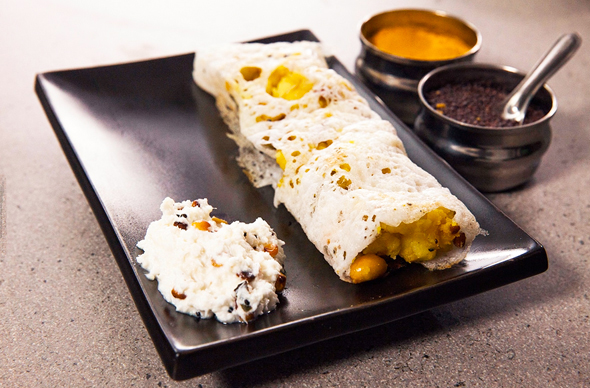Mama’s Punjabi Recipes: Dosa Aur Nariyal Chutney (South Indian Crepes & Coconut Chutney)
Although dosas (crepes) are not a Punjabi dish, over the past few decades they have been so popular in North India that they could be considered a local dish, found in many restaurants and even at street vendor stalls.
Dosa is a traditional Tamil dish, with references in the Sangam literature of the 1st century AD. The origin of the soft and thick version is associated with the restaurants from the Udipi district. The thinner and crispier variety which has become widely popular was first made in present-day Karnataka.
The main ingredients of dosas are rice and skinless urad lentils and are usually served with a stuffing of potatoes, sambar and chutney, though the softer, thicker ones go well with chutney alone. After Independence, South Indian cuisine drifted across the country and in New Delhi it was first served at the Madras Hotel in Connaught Place where it became wildly popular. Udipi restaurants started to flourish in Bombay in the 1930’s.
Dosas are high in carbohydrates but are also a good source of protein. The rice and lentils are allowed to ferment in order to make a batter, and this increases the vitamin B and vitamin C content. Instant dosa mixes usually contain higher amounts of rice. In this recipe, a small amount of methi (fenugreek) seeds are added to enhance the flavor.
Dosas can be served with chutney and sambar (a thin, lentil-based spicy vegetable soup) or stuffed with cooked spicy potatoes or pickles. Another version called the Rava dosa uses suji (semolina) and others replace the rice with refined wheat.
Dosas are popular because they are so quick and simple to make and the flavor and texture is very appealing to most palettes. Rather than run for some instant mixes, I hope that younger people will see how simple the ingredients are and try to enjoy making dosas at home themselves. This recipe does not use any dahin (yogurt). The chutney recipe is also quite simple, but other pickles and chutneys can be substituted.
Ingredients:
For Dosa:
• 4 cups chawal ka atta (rice flour)
• 1 cup dhuli urad ki daal ka atta (skinless urad lentil flour)
• 2 tsp methi danna powder (fenugreek powder)
• 5 cups pani (water)
• Some tael (vegetable oil) – for cooking dosas
• Spices to taste: namak (salt), mirch (red pepper
For Chutney:
• 1 cup kuta hua nariyal (grated coconut)
• 1/4 cup hari mirch (green chillies)
• 2 tbsp imbli paste (tamarind paste)
• 2 cups pani (water)
Directions:
For Dosa:
1. If you are unable to find the urad daal flour or methi danna powder, you can take the same amounts and grind them finely.
2. Mix all the chawal atta, urad atta and methi danna powder together in a bowl.
3. Pour in the water and mix well making sure there are no clumps in the mixture.
4. Cover the bowl and leave it inside the oven overnight. Do NOT turn the oven on but leave the oven light on. This will help the mixture to ferment overnight.
5. In the morning, take the bowl out of the oven and stir to check consistency. The batter should be thick enough to spread.
6. Heat up a large skillet or flat tava over medium high heat and use the oil to coat the surface. Put a drop of the batter on it to test: if it easily sizzles and bubbles, then the skillet is ready to use.
7. Pour some batter on the skillet and spread it around to make a 6 to 8 inch pancake disk. When it is full of little holes, turn it over with a spatula. Add a dab of oil around the edges to make the dosa crisper.
8. The dosa is ready when both sides are golden brown.
9. Serve hot from the skillet onto a plate with the coconut chutney.
For Chutney:
1. Wash the green chilies and then cut into small pieces.
2. In a small bowl, mix the chopped chilies and grated coconut together.
3. Add the imbli paste and pour in the water slowly, stirring continuously to mix well.
4. Leave in the fridge to chill for 30 minutes before serving.

Shakuntla Malhotra is a skilled cook of Punjabi dishes made in the old-fashioned style that she learnt as a young woman in her ancestral home in Lyallpur, India (since renamed Faisalabad) before it became part of Pakistan after the Partition in 1947. People have often admired her cooking for its simplicity and taste that comes with each mouthful. Even in her late-eighties, she continues to cook daily and agreed to share her delectable Punjabi vegetarian recipes for future generations.

